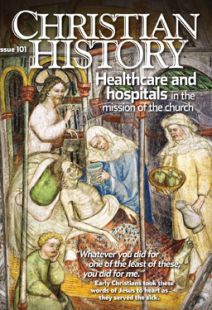deaconesses
WHO WERE deaconesses in the early church? They served important roles both liturgically and practically. Since catechumens (candidates for baptism) were stripped naked and anointed with oil before the ceremony, during which they wore a clean white robe, someone of the same gender was needed to help them in their preparations. Deaconesses not only prepared women before baptism, but also instructed them afterward. Says the Didascalia Apostolorum, a third-century Syrian book of church laws:
And when she who is being baptized has come up from the water, let the deaconess receive her, and teach and instruct her how the seal of baptism ought to be [kept] unbroken in purity and holiness. For this cause we say that the ministry of a woman deacon is especially needful and important. For our Lord and Saviour also was ministered unto by women ministers, Mary Magdalene, and Mary the daughter of James and mother of Jose, and the mother of the sons of Zebedee, with other women beside.
The fourth-century Apostolic Constitutions instruct deaconesses to guard the door during the service and to maintain order among women attending the services.
Deaconesses, like deacons, also ministered to the sick and poor. The Didascalia lists among the roles of deaconesses visiting the sick, ministering to the needy, and bathing those recovering from sickness. The rationale for having this special class of church workers to care for the sick was simple: “If then our Lord did thus, will you, O deacons, hesitate to do the like for them that are sick and infirm, you who are workmen of the truth, and bear the likeness of Christ?”
The order of deaconesses overlapped the order of widows, who were also seen as having special responsibility for the poor and sick (according to the Apostolic Constitutions, they were to “care for nothing else than to pray on behalf of those who give and the whole church”). Widows normally were to be over the age of 60 so there was less likelihood they would leave the order to marry again, and were to have distinguished themselves by their good works, godly demeanor, and offers of hospitality to strangers.
In the East, deaconesses were ordained (similar evidence has not survived from the West). The Apostolic Constitutions direct:
O Bishop, thou shalt lay thy hands upon her with all the Presbytery and the deacons and the deaconesses and thou shalt say: Eternal God, the Father of Our Lord Jesus Christ, the creator of man and woman, that didst fill with the Spirit Mary and Deborah, and Anna and Huldah, that didst not disdain that thine only begotten Son should be born of a woman … Do thou now look on this thy handmaid, who is appointed unto the office of a Deaconess and grant unto her the Holy Spirit … that she may worthily accomplish the work committed unto her, to thy glory and the praise of thy Christ.”
By the editors
[Christian History originally published this article in Christian History Issue #101 in 2011]
Next articles
We learn not to fear death
Despite persecution and the danger of contagion, North African Christians tended plague victims
Cyprian of CarthagePeople of faith: Recommended resources part 2
Resources for Christian engagement with culture.
the editorsSupport us
Christian History Institute (CHI) is a non-profit Pennsylvania corporation founded in 1982. Your donations support the continuation of this ministry
Donate



